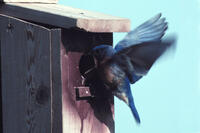Bird Houses
Building and placing bird houses is a popular hobby for thousands of Kansans. This gives many people fulfillment and some satisfaction that they may be helping our feathered friends. In our backyards, there may be several opportunities for bird houses. The brochure below gives simple designs for construction of four types of bird houses for species most likely to use your backyard. They include house wrens, American robins, northern flickers, American kestrels, and purple martins. While wrens, flickers, and robins may be attracted to trees and shrubs near your house, kestrels and martins like a little more room.
The bird most people will likely attract will be the house wren. Wren houses should be placed 5 to 10 feet above the ground, under the eaves of a building or hanging in a tree. No perch is needed. Clean the box after each brood.
Place a purple martin house about 10 feet high, preferably on a retractable pole, at least 30 feet from any trees. It is important to clean all bird houses very early in the spring. A handful of sawdust may be used in the bottom of each compartment of a martin house along with a small pinch of rotenone to reduce future problems with lice. It is important to keep house sparrows out of martin houses because the desirable birds will not nest with the sparrows. Weekly maintenance is required to remove sparrow nesting material similar to bluebird houses (See bluebird brochure in this series).
Put a kestrel box on a tree or post at least 10 feet high (in open country, if you have a large yard or country home). The secret to attracting flickers is to use 1 1/2-inch thick cedar boards for nest boxes and to fill the interior of the box all the way to the top with sawdust. These boxes should be placed 4 to 6 feet high along fence-rows that border crop fields, pastures, or woodlots.








